There are of course, many other organisms that may arrive
within
our systems as hitch hikers within and on live rock and sand as well as
being introduced as water or air borne arrivals. Their presence is
usually never noticed until the aquarium conditions favor their
sudden growth. While impossible to be totally rid of such organisms,
they can be controlled and limited if you understand their needs and
are then able to deny them of those needs.
CYANOBACTERIA
- Right after algae, the cyanobacteria are the most frequently
encountered organism. While it will always be present within our
aquariums there are of course conditions that favor its growth, the
link I provided will be of use in learning how to limit it. Being a
bacteria, I do not suggest you use any anti-bacterial product within
your system and instead learn of its needs and then deny it of those
needs.
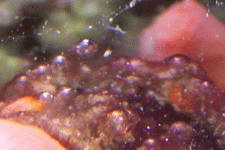
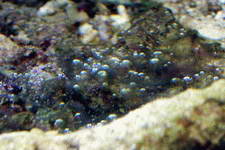 DIATOMS
DIATOMS
- Very similar in appearance to cyanobacteria but is instead a
photosynthetic algae which uses silicates to build its structures. As
with any pest, the best control is to learn of its needs and then deny
it of those needs. Silicate based sands will not provide this algae
with a food source as such silicates must be soluble.
 FILAMENT ALGAE
FILAMENT ALGAE
- No matter its coloration, any of the filamentatious algae can quickly
gain ground in our aquariums, while the limiting of its nutrient
sources may slow its spread, it is best kept in check with having
herbivores such as certain fish and snail species. I do not
advocate the use of any crab species as they are omnivores and may
turn to meatier items within your aquarium that you wish to keep, such
as other inverts.

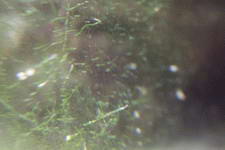
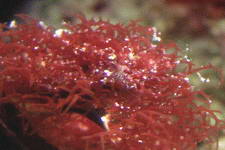 CORALLINE ALGAE
CORALLINE ALGAE -
While looking like a colorful rock, this is in fact a
plant and may be found in many colors and shapes, not all of which are
encrusting but may form branches as well. Many of the species found
growing as a colorful calcified "rock" do have specific levels of light
requirements, some prefer the intensity of light that can be found in a
typical reef aquarium while others prefer much more subdued lighting.
Changes in lighting usually results in this algae bleaching out and
dieing off only to have another species start to grow in its place.
Calcium levels of the aquarium should be monitored as this type of
algae can pull alot of calcium out of the water in a single day.
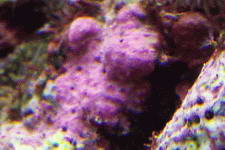
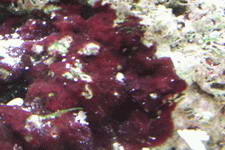
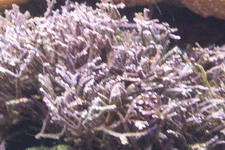 MACRO ALGAE
MACRO ALGAE
- With a great many species that can be found as
hitch
hikers upon live rock, I will of course not be able to show all of the
possibles and will instead, show but a few of the more common as well
as the more unusual species. The main link provided leads to a very
indepth macro algae identification site.
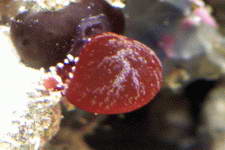
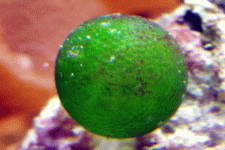
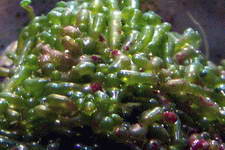
(
Botryocladia pseudodichotoma
)
(Ventricaria
ventricosa)
(Valonia utricularis
2)
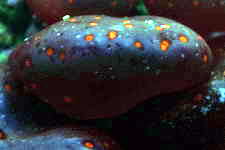 One
of many Red bubble algae
Fungal
One
of many Red bubble algae
Fungal
& Bacterial Mats - Most often seen as a thin spider web looking mat
on newly
purchased or mishandled live rock where there has been a die off of
other life forms on the rock. Food particles or dead animals left
laying about the tank will also develop fungal and bacterial growths as well. As
shown in the above photographs.

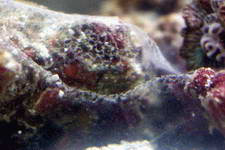
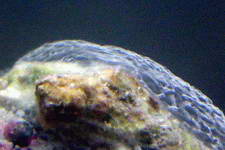
MICRO ALGAE - As the name implies,
these are very
small plants which quickly and easily colonize any surface area and is
most often seen as a brown and/or green film on the glass of the
aquarium and will also grow as a green "staining" of rocks
and
sand. With the correct species of snails, and in sufficient numbers,
this type of algae can be kept in check.
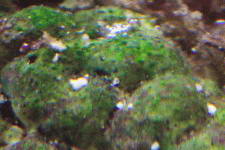 CHRYSOPHYTES
CHRYSOPHYTES
- A marine silicate based algae, which if it has
become a
problem within your aquarium, reducing the amount of dissolved
silicates and other nutrients will help to reduce it or at least keep
it from dominating the aquarium.
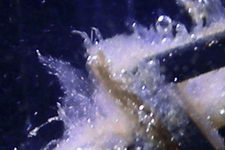
©
2016 ALL RIGHTS RESERVED
All content and photographs
are copyright protected and
may not be copied or
reproduced elsewhere without the
permission of the authors.
Please take a moment and
consider supporting any one of the projects listed within. Thank you.
s.



















